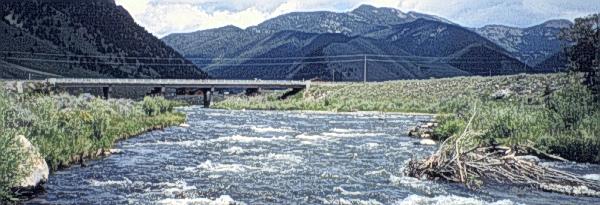Aquatic Invertebrates of Montana
Quake Lake to Lyons Bridge

While Tubifex cannot be missed below Hebgen, it can scarcely be found below Quake Lake. I have also seen this pattern at other sites. It seems Tubifex loves deep reservoir outflows, but it hates lake outflows. Quake Lake largely counters the affects of Hebgen Dam- we are lucky they are not reversed in their order on the river! The details of this response should also be studied as they could offer some management options.
At Raynolds Pass I have 4 samples (64, 123, 148 and 278) all with huge numbers of oligochaetes despite the large substrate size and the very rapid current velocity. Of the 365 worms closely examined, only 3 are positively Tubifex and 7 others are immature, but probably Tubifex. The only positive Tubifex came from a spring sample, which is normally the best time to find mature Tubifex. Rhyacodrilus dominates the worm community at this site, at least among the tubificids.
The area of reduced Tubifex is short. By Lyons Bridge, Tubifex is again well represented in the worm community, about equal with Rhyacodrilus and total oligochaete numbers remain very high. This is based on 2 samples (149 and 314). The West Fork Madison River carries a heavy load of sediment and manure and it has a substantial Tubifex population of its own. I would not surprised if it is a bigger problem for the upper Madison fish than is the mainstem. Because of regulation at Hebgen Dam, the Madison River is less able to transport this loading from the West Fork.
On January 22, 1997 I got good inventory class samples from above the West Fork (312) and below the West Fork at Lyons Bridge (314). These samples help clarify the situation here. I found 29 non-worm taxa with 14 EPT above the West Fork, and below the West Fork I found only 16 non-worm taxa with 9 EPT. Above the West Fork, the oligochaete density was high with 9 species present. None of these were mature Tubifex, but 36 of 122 worms that were mounted were probably immature Tubifex. Below the West Fork, the oligochaete density was very high, but with only 6 species present. Of the 148 worms mounted, there were 33 mature Tubifex and 6 more that were immature. The West Fork really is the bigger problem in this area. The Madison River between Quake Lake and the West Fork is probably only marginally suitable for Tubifex. Year-to-year variation in Tubifex here may explain the year-to-year variation in whirling disease severity. 1996 was a bad year for whirling disease as expected and 1997 should be worse, based on current snowpack. This creates an unique natural experiment area, which may eventually lead to management options at Hebgen Dam and Quake Lake.
Aquatic Oligochaete species list
- Eiseniella tetraedra (Savigny)
- Rhynchelmis sp?
- Limnodrilus hoffmeisteri Claparede
- Rhyacodrilus coccineus (Vejdovsky)
- Tubifex tubifex (Muller)
- Telmatodrilus vejdovskyi Eisen
- Chaetogaster sp. prob. diaphanus (Gruithuisen)
- Specaria? sp.
- Nais sp. or spp.
- Enchytraeidae 2+ spp.
5 JAN 1997, Updated on 12 FEB 1997 D.L. Gustafson
Back to the Madison River Tubifex Summary
AIM home page
dlg@rivers.oscs.montana.edu
